Is the minimum support price scheme helping the farmers, or is at failing them at several levels? A simple math
Whenever the government increases the minimum support price of crops, it claims that it is going to benefit the farmers and increase their income, but is this claim true? When the government is continuously increasing the MSP rates, why are the farmers agitating?
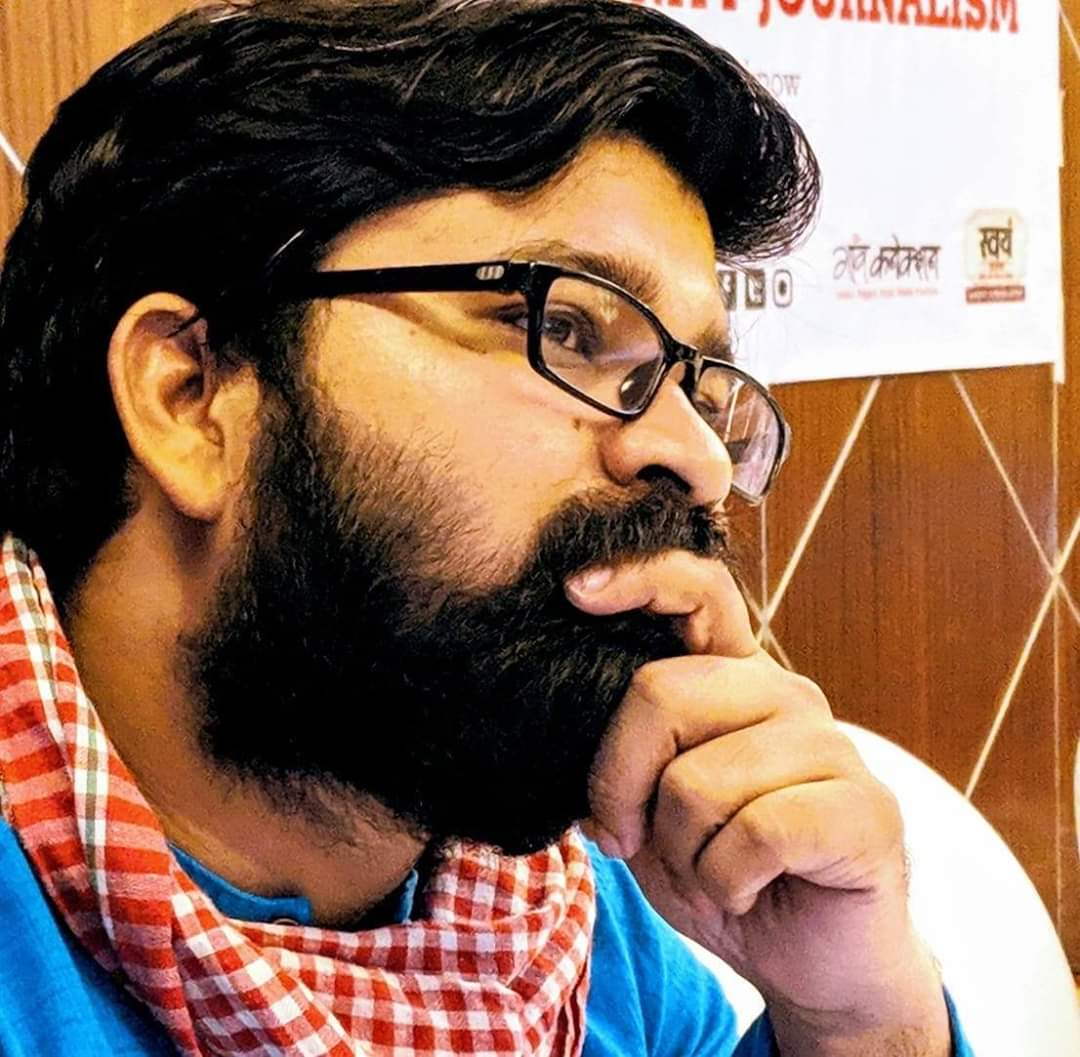
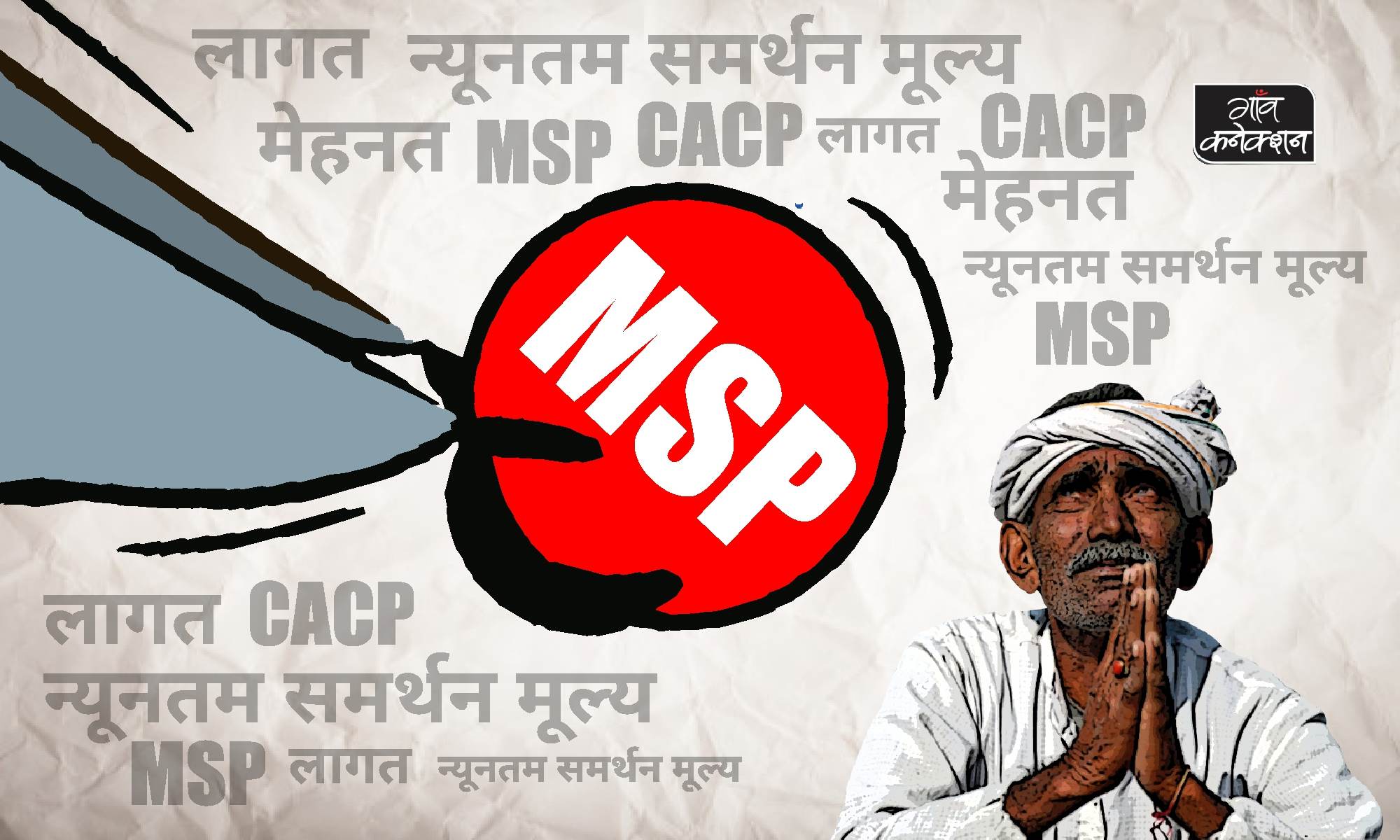
In order to provide relief to farmers amid the nationwide lockdown, the central government increased the minimum support price (MSP) of 14 Kharif crops on June 2, 2020. Terming the decision as historic, the country’s agriculture minister said that this will greatly benefit the farmers of the country. Just a week later, thousands of maize farmers from Madhya Pradesh carried out a Satyagraha Andolan and took to fasting demanding an MSP for their produce. In October 2019, the government had increased the MSP of rabi crops as well.
When the government is continuously increasing the rates of MSP, why are the farmers agitating? While every time the government hails it a major decision in the interest of farmers, does it really benefit the farmers across the country? Does the increase in MSP really give the farmers a good price for their produce?
First, let us understand, in simple terms, what is MSP and how it is decided.
The history of MSP
The condition of the Indian farmers was not very good since independence. The farmers were getting very poor prices for their crops despite putting a lot of hard work and money. The sale and purchase of agricultural commodities was going on as per the states. When the grains output was low, the prices would soar and when the output was good, the prices would crumble. To control this, the central government constituted the Food-Grain Enquiry Committee in 1957. The Committee’s recommendations proved largely ineffective. Then the government thought of regulating the price of foodgrains.
For this purpose, Prime Minister Lal Bahadur Shastri constituted the Food Grain Price Committee, headed by his secretary Lakshmi Kant Jha (LK Jha), under the Ministry of Food and Agriculture (now these two ministries work separately), in the year 1964. Shastri was of the view that farmers should get at least so much money for their produce that they do not suffer any loss. Chidambaram Subramaniam was the country’s agriculture minister at that time.
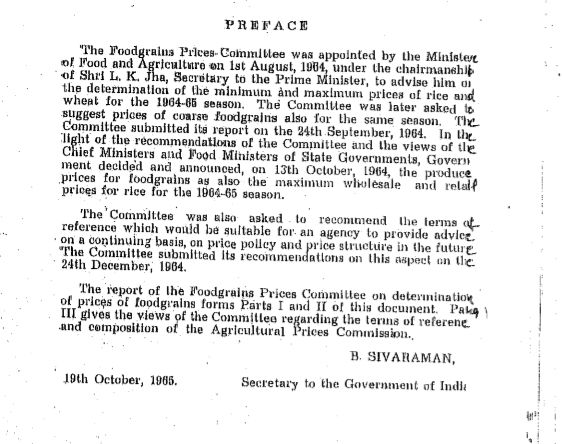
The Food Grain Price Committee, along with LK Jha, also included TP Singh (member, Planning Commission), BN Adarkar (Additional Secretary, Economic Affairs, Ministry of Finance), ML Dantwala (Department of Economic Affairs) and SC Chaudhary (Economic and Statistical Consultant, Ministry of Food and Agriculture).
Dr BV Dutia (Deputy Economic and Statistical Consultant, Ministry of Food and Agriculture) was appointed as the Secretary of the Committee. The Committee submitted its report to the government on December 24, 1964. Prime Minister Lal Bahadur Shastri had approved it on the same day, but the number of crops to be covered was yet to be decided.
On October 19, 1965, B Shivraman the then Secretary, Government of India, gave the formal approval to the Committee’s proposal. Thereafter, for the first time, in 1966-67, the minimum support price (MSP) of wheat and paddy was fixed. To fix the price, the central government constituted the Agricultural Prices Commission, which was later renamed as the Commission for Agricultural Costs and Prices (CACP) in 1985.
This means that the minimum support price (MSP) system was introduced in the country to protect the interests of the farmers in general. Under this system, even if the price of a crop falls in the market, the central government procures it at the fixed MSP from the farmers so that they can be shielded against losses.
The MSP of a crop is the same throughout the country and 23 crops are now being procured under the scheme. The MSP is fixed on the basis of recommendations of the Commission for Agricultural Costs and Prices under the Ministry of Agriculture, Government of India.
The Food Corporation of India (FCI) was constituted in 1965 on the recommendation of the LK Jha Committee. The government stores the grains procured from the farmers with the FCI and NAFED (National Agricultural Cooperative Marketing Federation of India) from where the grains are distributed to the poor under the Public Distribution System (PDS).
How is the MSP fixed?
Since 2009, the Commission for Agricultural Costs and Prices fixes the minimum support price of a crop based on cost, demand, supply position, price changes, market price trend, different costs and international market prices.
The Ministry of Agriculture also claims that the cost of production of cultivation does not only include cash expenditure (as per market) but also the cost of labour (as per market rate). This means that agricultural wage rate is also considered while setting up of the MSP.
To assess the MSP, the CACP divides the cost of cultivation into three parts — A2, A2 + FL and C2. A2 includes all cash expenses incurred by farmers towards crop production such as seeds, manure, fuel and irrigation, etc, while A2 + FL also adds estimated wages of the farmer family to the cost of crop-production to the cash expenditure.
The commercial model of cultivation is adopted in the C2. It also includes the total cash cost, the interest on farm land rent and the total agricultural capital besides the farmer’s family wages. Presenting the budget on the behalf of the central government in February 2018, the then Finance Minister Arun Jaitley had said that the price of the farmers’ crops will be at least one-and-a-half-times higher than their cost.
The CACP report shows that the MSP is based upon A2 + FL model. Constituted in the year 2004, Prof MS Swaminathan Committee, also known as the National Commission for Farmers, submitted its report to the government in October 2006. The report advocated the farmers to be paid the price of their crop based upon C2, while this is not happening.
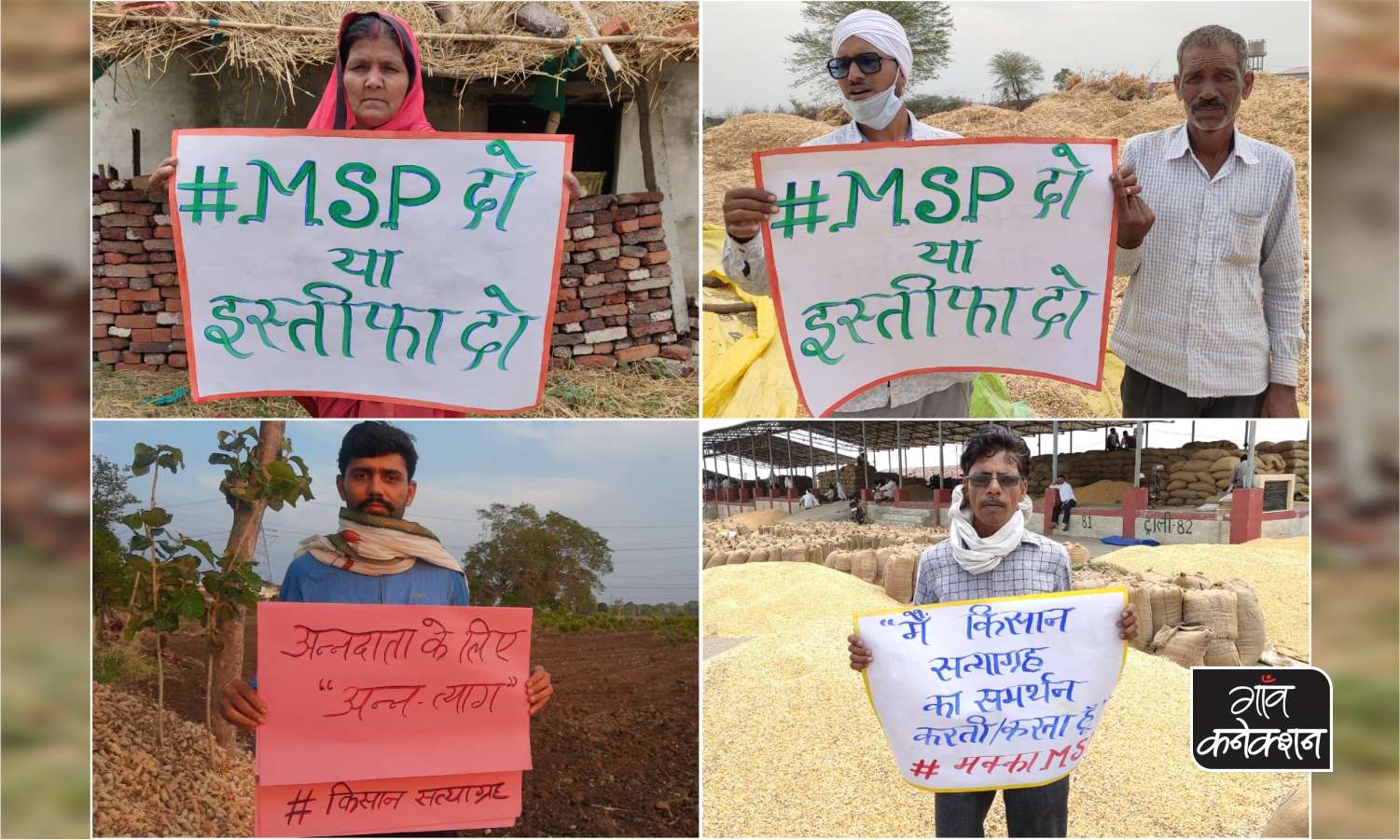
Is the MSP benefiting the farmers?
Even though this policy has been implemented for the good of the farmers, it is also important to know whether the farmers are actually benefiting from it. Whenever the governments have hiked the MSP, they have claimed that it was going to benefit the farmers of the country greatly, but the actual truth can be well understood with a recent example. As per the government’s declaration, the minimum support price of maize in the country should be Rs 1,850 per quintal, but farmer Satish Rai gives us the real picture.
Satish lives in the Seoni district of Madhya Pradesh and has also participated in the Satyagraha against low prices. “The government has declared maize MSP as Rs 1,850, while maize is selling for as low as Rs 900 to Rs 1,000 in the mandis of Madhya Pradesh and the farmers are incurring losses up to Rs 900 to Rs 1,000 per quintal. That is why, in distress, we had to resort to such measures (Kisan Satyagraha),” he said.
According to the central government, the price of maize should be at least Rs 1,850, but actual rate ranges between Rs 900 and Rs 1,000 per quintal. Talking about the report of the Commission for Agricultural Costs and Prices fixing the price and cost of crops, the cost of cultivation of maize per quintal in the country comes to Rs 1,213. This means, the MSP apart, which is the government price, the farmers are incurring a loss of Rs 200-300 instead of any profit.
Rai said: “Going by the government figures, the farmers are incurring a loss of Rs 213 to 313 per quintal (Rs. 1213) upon their production cost and considering the MSP, Rs 800-900. According to a rough estimate, maize was sown in 4.35 lakh acres in the Seoni district alone that has caused a loss of Rs 600 crore to the farmers of the district in the absence of the SSP.
It is not that the farmers are getting lower price for maize alone. The price of chana ranged between Rs 3,000 and 3,200 per quintal when Murli Dhar, a farmer from Putalur village in Anantapur, Andhra Pradesh, reached Tadpatri Mandi on March 20, 2020. He had arrived at the mandi with about 25 quintals chana, but sold only half of it.
He explained: “Even if we get the government rate, we are happy with that, but I was getting Rs 3,100 for a quintal. Now, I couldn’t have sold my chana by incurring so much loss, but I had already invested effort time and money bringing my produce to the market so I couldn’t have also gone back without money. So, I sold only half and the remaining half I would sell when the price is right.”
Murli Dhar got Rs 3,100 for a quintal whereas the government has fixed the MSP of gram at Rs 4,875 per quintal. So, he ended up losing Rs 1,775 per quintal in terms of the MSP. It is not a matter of one farmer in particular, but several reports have confirmed that farmers are not able to get the benefit of the MSP.
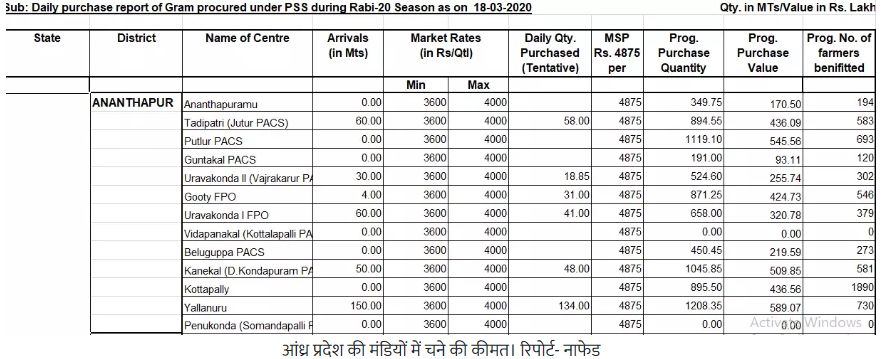
According to a report by the Organisation of Economic Cooperation Development and the Indian Council of Agricultural Research (OECD-ICAIR), the farmers have lost Rs 45 lakh crore due to non-proper pricing of the product between 2000 and 2017.
The Shanta Kumar Committee, formed to suggest restructuring of the Food Corporation of India (FCI) in 2015, in its report, had stated that only 6 per cent of the MSP could be received by the farmers, which directly means that 94 per cent of the farmers in the country are deprived from the benefit of the MSP. According to the government, the number of farmers in the country is 14.5 crore, so the number of farmers benefited (6 per cent of the total number of farmers) is 87 lakh.
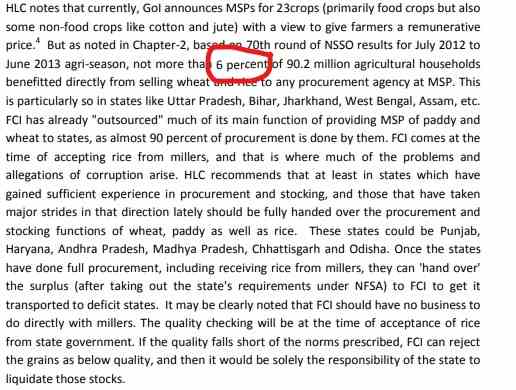
In 2016, a startling report of NITI Aayog on the MSP had revealed that 81 per cent of the farmers knew that the government would give MSP on many crops, but only 10 per cent of the farmers were aware of the right price before the sowing season. So, the question also arises that if the farmers are so distant from the biggest system for fair price, how would they be given fair price?
In 2019, when Gaon Connection, in its survey conducted among 18,267 people in 19 states of the country, asked the farmers to name the biggest problem for farming today, 43.6 per cent of the farmers said that the biggest problem for them is not getting the right price. These were 4,649 respondents.
Fixed price is also problematic for the farmers
The price of any crop decided by the central government remains the same all over the country. This is also a major reason why the farmers are not able to get the benefit of the MSP, because the cost of cultivation varies across states. Let us see this with an example.
Talking about the CACP as the basis, in the year 2016-17,the farmers of Karnataka cultivated maize in one hectare with their total expenditure falling close to Rs 28,220, whereas the farmers of Bihar spent about Rs 32,262 for cultivation in the same area, the farmers of Jharkhand spent Rs 24,716 and Maharashtra farmers Rs 51,408, whereas, on maize, the central government gives MSP of Rs 1,760. The MSP of maize has now been increased to Rs 1,850.
Apart from the cost, production output varies too. The country had an average yield of 33 quintal maize in one hectare during the year 2017-18, but the production varied state-wise. Tamil Nadu produces 65.5 quintals in one hectare while in Andhra Pradesh 68.2 quintal maize was produced in the same area. The same area in Bihar yielded 36.4 quintals per hectare.
The major reason behind the cost of production is the wage rate which varies in every state. In Andhra Pradesh, the one-day agricultural wage rate is Rs 312 (as on January 2018) while the same rate in Assam is 277, Bihar 264, 236 in Gujarat, 367 in Haryana, 439 in Himachal Pradesh, 321 in Karnataka, 691 in Kerala, 298 in Madhya Pradesh, 226 in Odisha, 349 in Punjab, 267 in Rajasthan, 424 in Tamil Nadu, 243 in Uttar Pradesh and Rs 275 in Punjab while the all-India average agricultural wage rate is only Rs 283.

To understand this better, we also spoke to the assistant director of the Commission for Agricultural Costs and Prices, Sube Singh. “The central government decides the MSP upon the basis of the average expenditure. It is also a state matter. The state governments have the right to increase the MSP according to their parameters. They can enhance it,” he said.
According to the assistant director, it is also a state matter, but when the state government talks about giving bonus on crops, the Commission calls it a distortion. It is also mentioned in the Kharif 2019-20 report.
The report reads: “Some state governments have been giving bonuses on minimum support, especially for paddy during the last few years, causing distortions in the market and causing damage to the private sector. During the years 2017-18 and 2018-19, states like Kerala, Tamil Nadu and Chhattisgarh declared bonus for paddy. For example, Chhattisgarh declared a bonus of Rs 750 per quintal for paddy in 2018-19, which is about 43 per cent of the MSP. Similarly, Kerala paid a bonus of Rs 760 per quintal for Paddy Grade A in 2018-19 and Rs 780 per quintal for Paddy General.”
The report further mentions: “The government procurement of rice in Chhattisgarh is much higher than what is required under the NFSA (National Food Security Act) and other schemes. Therefore, it would be difficult for the state to dispose of additional reserves. Bonus at the MSP affects the crop balance.” The Commission has reiterated its earlier recommendation that such bonuses/bonuses should be stopped, especially in states where rice production is high.

Devinder Sharma, an expert on agricultural affairs, said: “The central government retains the right to MSP because it is up to it to decide how much stock to keep, how much to make available in the market. All these decisions have to be made by the Centre. But it is not that we cannot implement it according to the states. Now, if the cost of wheat in Punjab comes to Rs 2,500, the FCI should pay Rs 2,500 to the farmers and if the same cost comes to Rs 1,500 in Bihar, the government should pay Rs 1,500, but it doesn’t happens because there is no opposition to it. The farmers are not fully aware and the governments get through easily.”
He added: “The central government does not want this to happen. If the government of Madhya Pradesh and Chhattisgarh announced the bonus, the centre said that it would not buy the produce. This means that you do not want the state governments to do it. The whole policy needs to be changed, but the government will not allow it to happen because economists think that food items should be cheaper. This is to cap the inflation rate and to provide the industry with raw materials at cheaper rates.”
“Many times, I have demanded that the income of the farmers should be at least Rs 18,000 a month. Some people said that if that happens, the price rise will go up. Now, the way to avoid this is that if the government is buying wheat at Rs 1,900, it should buy it at the same rate and send the difference in cost to the farmers’ Jan Dhan account, so that it does not affect the price rise,” he further added.

The CACP has published a report on its website on Kharif season 2020-21. It has the complete information about 2019-20. The central government has recently improved the MSP of 14 kharif crops.
The report has briefed about the different crops state-wise. According to this, if we talk of paddy, the price of paddy in the market is less by 17 per cent in Assam, 10 per cent in Chhattisgarh, 7 per cent in Tamil Nadu, 4 per cent in Telangana, 6 per cent in Uttar Pradesh and 2 per cent in West Bengal from the government’s fixed MSP. This is just an example.
What needs to be done? Hear it from the experts
In the Gaon Connection survey (year 2019), it came to the fore that whatever process of crop procurement is going on, the farmers are upset with it. Of the 18,267 people surveyed, 62.2 per cent said they wanted to have the right to the price of their crop, and they wanted the right to decide it.
Devinder Sharma said: “I think, the time has come when we should move from price policy to income policy. Between 2009-10 and 2011-12, the MSP of wheat was 125 per cent higher, barley was 110 per cent higher and chana was 105 per cent higher. So, now the question arises, when the government says that it is benefiting the farmers more, what is so special about it?”
He added: “The same thing was being done by the UPA government earlier, and it never made big claims about it. I am confident that if I ask the farmers, they will also dismiss the government’s claim of hike in the procurement price because it does not sit anywhere around the actual cost of the crop. Suppose the government gives the MSP as per its claim, what will happen at the most? The government is not able to procure crops from the farmers at the present MSP, while everybody knows that only six per cent of the farmers are able to sell the crop at the MSP.”
“The Parliament should enact a law on minimum support price so that no trader can procure farmers’ crop below a fixed rate, and anyone doing that should be penalized and the farmers should be informed before sowing the crop at what rate their crop will be sold,” said VM Singh, the convener of the Kisan Sangharsh Samanvay Samiti, a committee of more than 200 farmers’ organizations.
“It should also be kept in mind that only 6 per cent of the farmers in the country get an MSP for their crops,” said Kedar Sirohi, the acting president of the Kisan Congress, Madhya Pradesh. “The rest of the farmers’ crops go to middlemen, sahukars and other touts. The finance minister has also not made it clear what arrangements will be made to provide MSP to 94 per cent of the farmers. The biggest question is of how to ensure that their produce be delivered to government procurement centres.”

